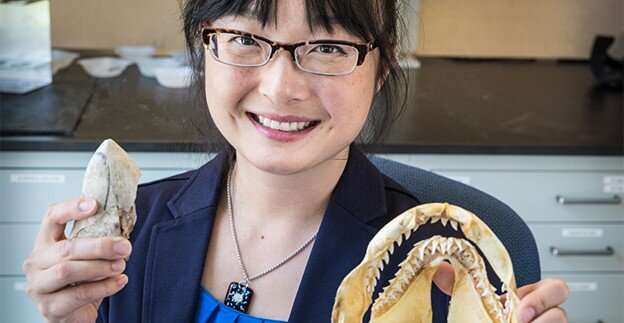Shark teeth offer clues to ancient climate change

Hooper, played by Richard Dreyfus in "Jaws," says that all sharks do is "swim and eat and make little sharks."
It turns out they do much more than that. Sharks have roamed Earth's oceans for more than 400 million years, quietly recording the planet's history.
If a researcher like paleoecologist Sora Kim of the University of California, Merced wants to "read" those records to learn about major global changes that took place 50 million years ago, she must decode the information stored in what remains of ancient sharks: their teeth.
Teeth from the long-extinct sand tiger shark are providing new information about global climate change and the movement of tectonic plates, which Kim and colleagues report in the journal Paleoceanography and Paleoclimatology.
For example, there's been debate about the timing and depth of the Drake Passage opening. The passage is the strait between South America and Antarctica, 620 miles wide and 11,000 feet deep, that allows ocean waters to mingle and form the Antarctic Circumpolar Current.
The opening, it was thought, led to the climate changing from greenhouse to icehouse. But the data Kim and her colleagues analyzed show something different.
"Analyzing isotopes in shark teeth, we can track the water-mass transfers between ocean basins and see when the passage opened," Kim said. "But we don't see evidence of a climate shift at that time. That will make people question what we think we know about the time and the area."
Supported by a grant from the U.S. National Science Foundation, Kim and her colleagues used shark teeth collected around Seymour Island near Antarctica.
"The results of this work are exciting as they integrate shark paleontological studies, geochemical analyses for environmental reconstruction and novel global climate model simulations to look at the timing and depth of the Drake Passage opening," said Michael Jackson, acting head of NSF's Antarctic Sciences Section.
Added Kim, "Shark teeth contain a lot of data. Their potential should be considered as part of other researchers' analyses and geologic reconstructions to study ancient climate."
More information: Sora L. Kim et al. Probing the Ecology and Climate of the Eocene Southern Ocean With Sand Tiger Sharks Striatolamia macrota, Paleoceanography and Paleoclimatology (2020). DOI: 10.1029/2020PA003997
Provided by National Science Foundation




















